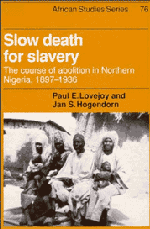Book contents
- Frontmatter
- Contents
- List of maps
- List of tables
- Preface
- 1 Slavery and the British conquest of Northern Nigeria
- 2 Fugitive slaves and the crisis in slavery policy
- 3 The debate on legal-status abolition
- 4 Emancipation and the law
- 5 Upholding proprietary rights to land
- 6 The role of taxation in the reform of slavery
- 7 The colonial economy and the slaves
- 8 The persistence of concubinage
- 9 Legal-status abolition: the final phase
- Appendix: Court records of slaves issued certificates of freedom
- Notes
- Glossary
- Bibliography
- Index
- Title in the series
9 - Legal-status abolition: the final phase
Published online by Cambridge University Press: 03 May 2011
- Frontmatter
- Contents
- List of maps
- List of tables
- Preface
- 1 Slavery and the British conquest of Northern Nigeria
- 2 Fugitive slaves and the crisis in slavery policy
- 3 The debate on legal-status abolition
- 4 Emancipation and the law
- 5 Upholding proprietary rights to land
- 6 The role of taxation in the reform of slavery
- 7 The colonial economy and the slaves
- 8 The persistence of concubinage
- 9 Legal-status abolition: the final phase
- Appendix: Court records of slaves issued certificates of freedom
- Notes
- Glossary
- Bibliography
- Index
- Title in the series
Summary
Many officials predicted that slavery would die a “natural death” as a result of the abolition of the legal status of slavery and the provision that children born after March 31, 1901 were free. There were repeated pronouncements that slavery was “virtually dead” or “no longer existed” beginning in the first decade of colonial rule and continuing almost annually for the next two decades. In 1924, G. S. Browne could claim that there had been “no disruption” caused by the Slavery Ordinance, and those slaves who had not taken “even more advantage … of the liberal terms of the Ordinance” had failed to do so
not because the people of the Northern Provinces are not aware that they can ransom themselves at any time they so desire, but because in many cases, and especially in the cases of the elder people, they are unwilling to leave those families to which they are connected by long ties of mutual cooperation and trust.
Browne insisted that slavery “is gradually dying out.”
Yet a state akin to slavery persisted, as we have seen. Slaves remained on their masters' lands, sometimes tilling the soil under sharecropping arrangements and other times paying rent and murgu. Women remained in the harems of the wealthy, and the free daughters of slaves were pressed into concubinage. Even the slave trade persisted, with children filtering through the net of the anti-slavery patrols. The “natural death” that was frequently announced by the architects of legal-status abolition was slow and tortuous.
- Type
- Chapter
- Information
- Slow Death for SlaveryThe Course of Abolition in Northern Nigeria 1897–1936, pp. 261 - 286Publisher: Cambridge University PressPrint publication year: 1993



